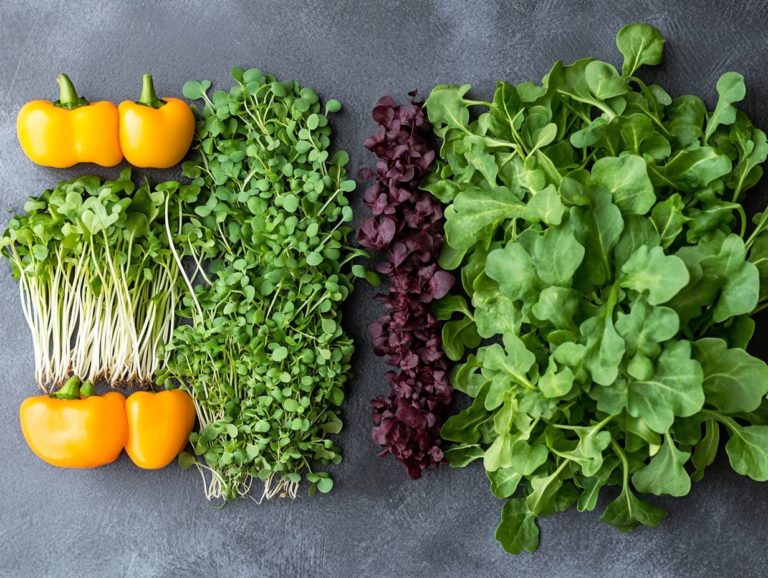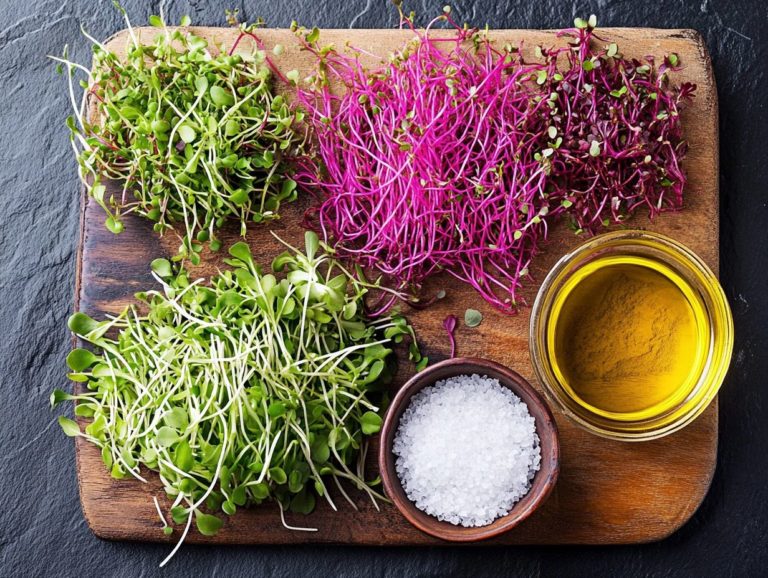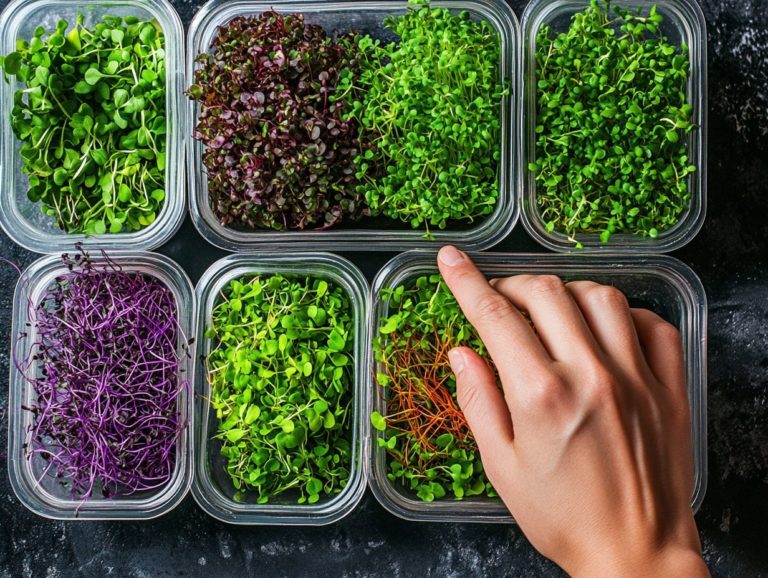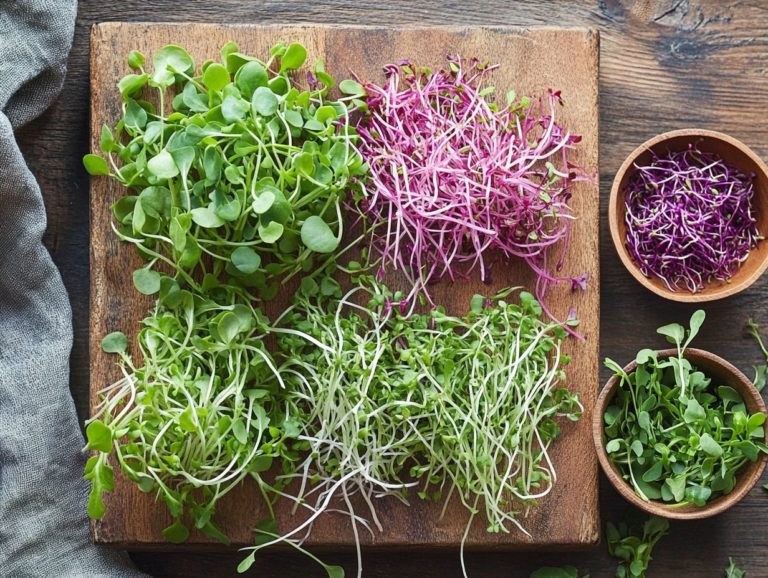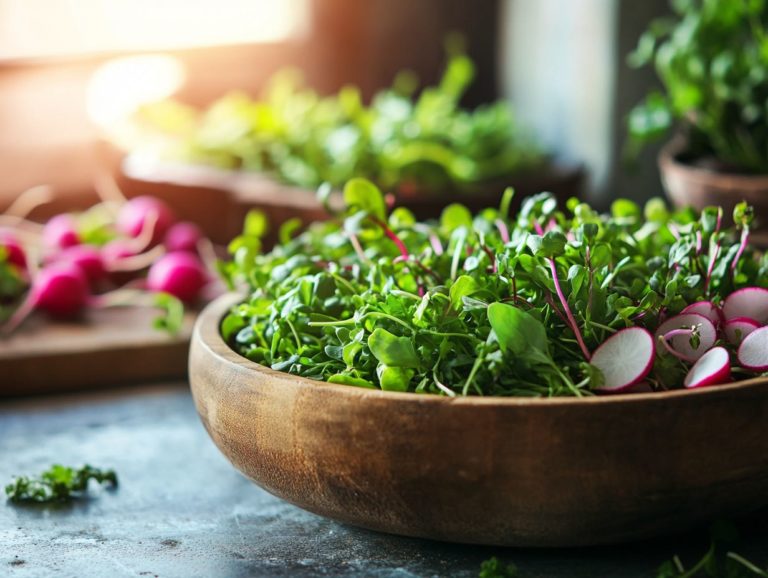How Microgreens Enhance Flavor and Health
Microgreens are tiny, nutrient-dense plants that deliver a delightful burst of flavor to your meals. More than just a colorful garnish, they boast impressive health benefits, making them an essential addition to any food lover’s list of favorite ingredients.
In this article, you’ll explore what microgreens are, the nutritional advantages they offer, and how they can enhance your dishes with their distinct flavors. You’ll also find practical tips for growing your own microgreens and discover popular varieties to enrich your culinary creations.
Get ready to explore the tasty and healthy world of microgreens, where their antioxidant properties play a key role in promoting a healthy diet!
Contents
- Key Takeaways:
- What are Microgreens?
- Flavor Profile of Microgreens
- Health Benefits of Microgreens
- Growing and Using Microgreens
- Popular Types of Microgreens
- Frequently Asked Questions
- What are microgreens and how do they enhance flavor and health?
- How do microgreens enhance the flavor of dishes?
- Can microgreens help improve overall health?
- How do microgreens compare to their mature counterparts in terms of nutrition?
- What are some ways to incorporate microgreens into meals?
- Are there any specific types of microgreens that are more beneficial for health?
Key Takeaways:
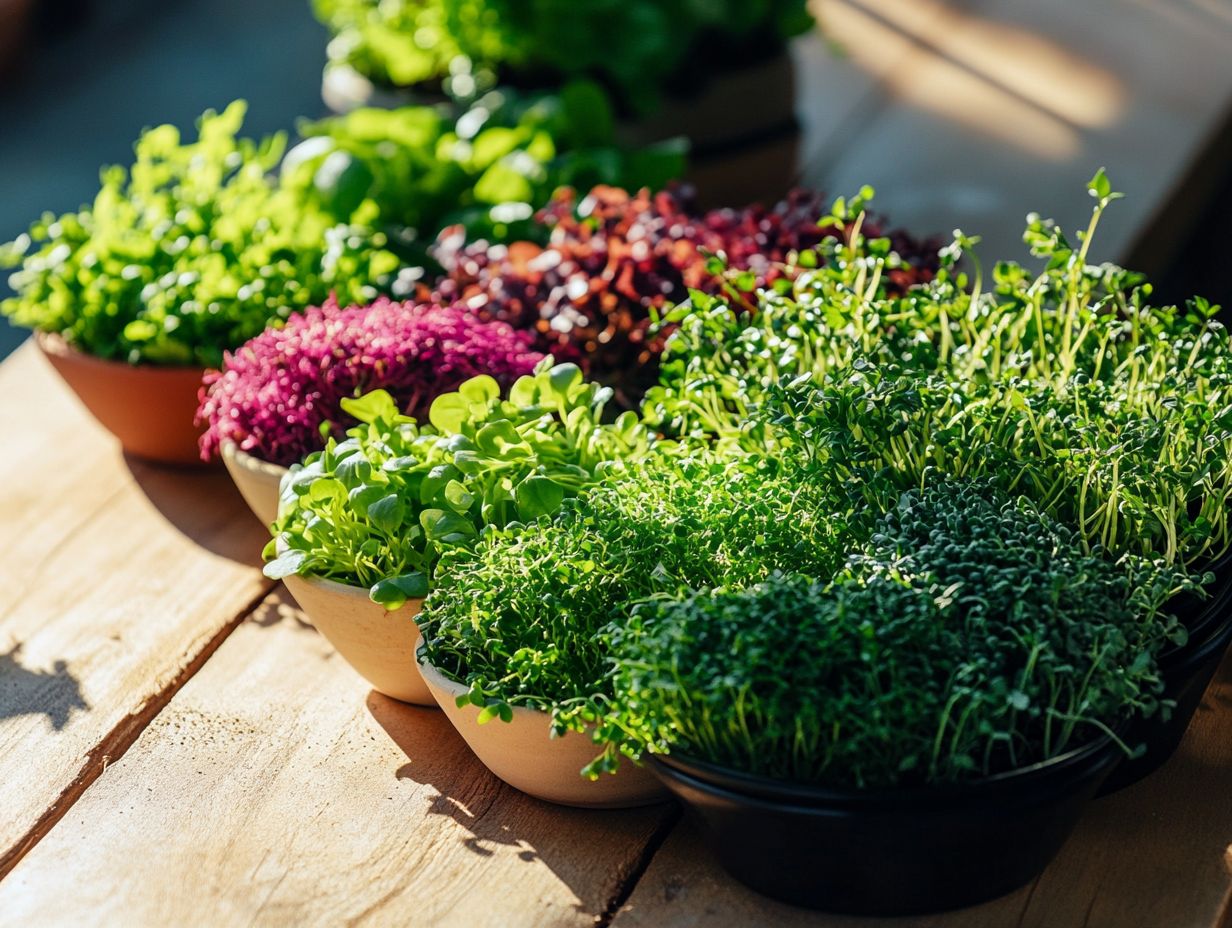
Here s what you need to know!
- Microgreens pack a powerful punch of concentrated nutrients, making them a great addition to any meal for added health benefits.
- These tiny greens are full of flavor, adding a vibrant and unique taste to dishes without the need for heavy seasonings or sauces.
- With easy-to-grow and versatile varieties, microgreens can be incorporated into a variety of meals for a boost in both flavor and nutrition.
What are Microgreens?
Microgreens are young vegetables and edible herbs you harvest right after the first set of real leaves that appear after the seed sprout. They offer a remarkable concentration of nutrients and vibrant flavors. These petite greens, often referred to as ‘vegetable confetti,’ have gained popularity in culinary circles for their rich nutritional benefits, including their role in cancer prevention, and distinctive flavor profiles.
You can easily improve your meals by adding them to your diet. Microgreens deliver an impressive punch, boasting higher levels of vitamins, minerals, and antioxidants than their fully grown counterparts. For instance, exploring the best microgreens for nutritional value can enhance your dishes even further.
Nutritional Value and Health Benefits
Microgreens are the delightful young seedlings of edible vegetables and herbs, harvested at a stage that ensures they re bursting with beneficial nutrients, essential for combating malnutrition. These little greens are not just cute; they pack a powerful punch, offering a rich array of vitamins, minerals, and antioxidants.
Take broccoli microgreens, for instance; they’re loaded with sulforaphane, a natural compound that helps reduce inflammation, making them beneficial for managing insulin resistance and Type 2 diabetes. Fenugreek microgreens, on the other hand, are a fantastic source of iron, making them perfect for anyone looking to naturally boost their iron intake. Exploring unique microgreens to elevate your dishes can also add variety and nutrition to your meals.
Incorporating these vibrant greens into your raw food diet does wonders for flavor while delivering a wealth of nutrients. To enhance your culinary experience, check out microgreen varieties: how to maximize flavor. Their versatility means you can toss them into salads, blend them into smoothies, or use them as garnishes, effortlessly incorporating them into your healthy diet.
Flavor Profile of Microgreens
The flavor profile of microgreens, including varieties like fenugreek and red cabbage, is remarkably diverse, with each variety presenting a distinct taste that can elevate a multitude of dishes. This versatility makes them an essential ingredient in the culinary world.
How Microgreens Enhance Dishes

Microgreens are not just pretty little additions; they can truly transform your dishes by adding layers of flavor and texture. They turn ordinary meals into extraordinary cooking experiences.
Consider how these tiny greens can elevate a simple green salad. They enhance not just flavor but also boost nutrient intake. When you toss them in, they provide a delightful crunch and a complex taste that lifts even the most basic ingredients to new heights.
In soups, microgreens shine as a vibrant garnish. They introduce a fresh burst that beautifully complements the rich flavors of the broth while also offering health benefits.
They also excel as garnishes, where their distinct flavors enhance both presentation and taste. Picture a bowl of creamy tomato soup finished with a sprinkle of basil microgreens. They introduce a peppery note that contrasts wonderfully with the velvety texture, creating a dish that is as comforting as it is sophisticated. For more on enhancing your culinary creations, check out this taste and flavor guide to different microgreen varieties.
Health Benefits of Microgreens
The health benefits of microgreens are remarkable. They offer a rich array of nutritional advantages crucial for disease prevention, including lowering cholesterol and enhancing overall wellness.
Incorporating these vibrant greens into your diet can elevate your health to new heights.
Nutrient Density and Disease Prevention
Microgreens are amazing! They re packed with nutrients, delivering a wealth of vitamins and minerals vital in disease prevention, particularly for concerns like iron deficiency, obesity, and heart disease risks.
These tiny plants not only provide a nutritional boost but may also support better brain health. Exploring microgreen varieties that enhance your garden highlights their potential in addressing conditions such as Alzheimer’s disease and even aiding in diabetes management.
Certain varieties, like kale and arugula microgreens, stand out for their impressive levels of antioxidants and essential nutrients. By incorporating these greens into your daily meals, you can enhance your overall well-being while potentially reducing the risks linked to serious health issues, including cancer prevention.
Therefore, the significance of microgreens transcends mere nutrition; it represents a proactive step toward a healthier lifestyle.
Growing and Using Microgreens
Start growing microgreens today to take your healthy diet to the next level! Growing microgreens at home is not only accessible, but also a rewarding pursuit that enables you to incorporate fresh, nutrient-dense elements into your meals, aligning with USDA guidelines for a healthy diet.
How to Grow and Incorporate Microgreens into Meals

Growing microgreens is a delightful venture that requires minimal space. It can be accomplished through straightforward methods, allowing you to effortlessly integrate these vibrant greens into your meals and support your raw food practices.
To kick off the process, selecting the right seeds is essential. Consider options like radish, sunflower, and basil, which are favored for their rapid growth and bold flavors. These contribute to their culinary applications.
Once you ve made your selection, prepare a shallow tray filled with quality potting mix. Ensure it has proper drainage to avoid waterlogging.
After sowing the seeds, give them a gentle mist and cover them to maintain humidity until they sprout. As they flourish, placing them in a well-lit area or under grow lights will amplify their flavor and enhance their nutrient profile. For those interested in maximizing health benefits, exploring the top microgreen varieties for health enthusiasts can provide valuable insights.
When it’s time to harvest, you’ll find microgreens to be a versatile ingredient. They’re perfect for elevating salads, sandwiches, or even blending into smoothies. To learn more about using them effectively, check out How to Incorporate Microgreens into Your Diet. This seamlessly enriches your everyday meals while addressing issues like malnutrition.
Popular Types of Microgreens
You ll discover a variety of popular microgreens, each boasting its own distinctive benefits and flavors tailored to satisfy diverse culinary needs and preferences, including those for managing insulin levels.
Varieties and Their Unique Benefits
Each variety of microgreens offers unique benefits, such as promoting heart health and enhancing your culinary creations.
Take arugula microgreens, for instance. They bring a delightful peppery kick, packed with vitamins A, C, and K. This makes them perfect for adding a zesty touch to salads or garnishing your favorite entrees, while contributing to your overall health. Broccoli microgreens are loaded with antioxidants that support detoxification and may reduce cancer risk. They are ideal for blending into smoothies or topping off sandwiches, thus boosting the nutritional value of your meals. For more tips on using microgreens, check out these ways to enhance flavor in microgreens.
Don’t overlook pea shoots, either. These sweet and tender greens are a fantastic source of protein, which can help manage obesity. They make a great addition to stir-fries and grain bowls. These tiny powerhouses elevate a variety of dishes, turning everyday meals into healthful culinary experiences that contribute to a healthy diet. Additionally, exploring the benefits of growing diverse microgreen varieties can further enhance your meals.
Frequently Asked Questions
What are microgreens and how do they enhance flavor and health?

Microgreens are young vegetable greens harvested when they are only a few inches tall. They are rich in nutrients, vitamins, and antioxidants. These include polyphenols natural compounds found in plants believed to have health benefits making them a great addition to any dish. Their concentrated flavor and nutrient content enhance flavor, promote good health, and help manage conditions like diabetes.
How do microgreens enhance the flavor of dishes?
Microgreens have a concentrated flavor that is much more intense than their mature counterparts. They add a burst of flavor to dishes, whether used as a garnish or mixed into the dish itself. With flavors ranging from spicy to sweet, they are versatile ingredients that enhance the taste of any dish while providing significant health benefits.
Can microgreens help improve overall health?
Yes, microgreens are packed with essential nutrients, vitamins, and antioxidants that support good health. They contain high levels of vitamins C, E, and K, as well as beta-carotene and lutein. These nutrients have been linked to reducing the risk of chronic diseases like heart disease and cancer.
How do microgreens compare to their mature counterparts in terms of nutrition?
Studies have shown that microgreens can contain up to 40 times more nutrients than their mature counterparts. They are harvested at an early stage when their nutrient content peaks, making them an excellent source for those looking to boost their health with natural foods.
What are some ways to incorporate microgreens into meals?
Get creative! Microgreens can transform your meals in countless ways. Add them to salads, sandwiches, smoothies, and soups. They also make beautiful garnishes for dishes like omelets, pastas, and pizzas. Their vibrant colors and unique flavors enhance any meal while boosting nutrient intake.
Are there any specific types of microgreens that are more beneficial for health?
All microgreens offer a variety of health benefits, but some may be more beneficial than others. For example, broccoli microgreens are high in sulforaphane, a compound linked to reducing certain cancer risks. Radish microgreens are packed with antioxidants, while sunflower microgreens are a good source of vitamin E. Incorporating a variety of microgreens into your diet is best to reap the full range of health benefits.

